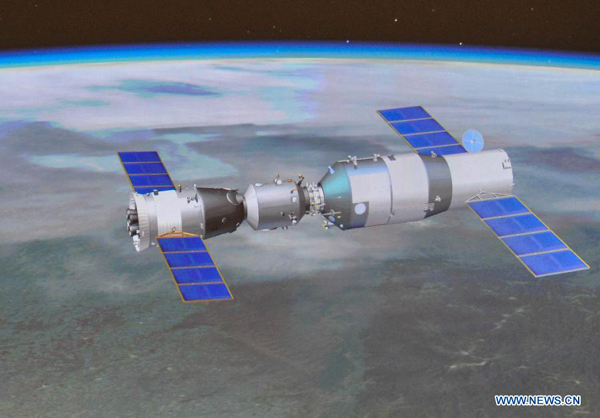
Shenzhou-10 Completes Automated Docking with Space Module
Jun 14, 2013 Email"> PrintText Size

China's Shenzhou-10 manned spacecraft successfully completed an automated docking procedure with the orbiting Tiangong-1 space module at 1:18 p.m. Thursday, according to the Beijing Aerospace Control Center.

Photo taken on June 13, 2013 shows the screen at the Beijing Aerospace Control Center showing a simulated picture of an automated docking between the Shenzhou-10 manned spacecraft and the orbiting Tiangong-1 space module. China's Shenzhou-10 manned spacecraft successfully completed an automated docking with the orbiting Tiangong-1 space module at 1:18 p.m. Thursday.(Xinhua/Liu Chan)
The docking procedure was the fifth to take place between Shenzhou-type spacecraft and the space module. Previous dockings include two automated operations by the unmanned Shenzhou-8 in 2011 and both an automated and manual docking by the manned Shenzhou-9 in 2012.
The Shenzhou-10, which was launched Tuesday afternoon from northwest China's Gobi desert, began to approach the Tiangong-1 automatically at 10:48 a.m. Thursday and made contact with the space module at 1:11 p.m..
Three astronauts aboard the Shenzhou monitored and reported the docking operation to the control center.
According to their mission schedule, the astronauts will enter the space module later and carry out scientific and technical experiments.
The Shenzhou-10 is China's fifth manned spacecraft and it is the first application-orientated flight under China's space program since the country introduced its manned space program in 1992.
The astronauts are scheduled to conduct a manual docking with the space module during their 15-day journey in space, as well as give a lecture to Earth-bound students.
China is the third country after the United States and Russia to acquire the technologies and skills necessary for space rendezvous and docking procedures, as well as supply manpower and material for an orbiting module via different docking methods.
The Tiangong-1 space lab has been in orbit for about 620 days. It will remain in service for another three months.
The module is considered the first step in building a permanent space station, which the country aims to do by 2020. (Xinhua)
China's Shenzhou-10 manned spacecraft successfully completed an automated docking procedure with the orbiting Tiangong-1 space module at 1:18 p.m. Thursday, according to the Beijing Aerospace Control Center.
 |
| Photo taken on June 13, 2013 shows the screen at the Beijing Aerospace Control Center showing a simulated picture of an automated docking between the Shenzhou-10 manned spacecraft and the orbiting Tiangong-1 space module. China's Shenzhou-10 manned spacecraft successfully completed an automated docking with the orbiting Tiangong-1 space module at 1:18 p.m. Thursday.(Xinhua/Liu Chan) |
The docking procedure was the fifth to take place between Shenzhou-type spacecraft and the space module. Previous dockings include two automated operations by the unmanned Shenzhou-8 in 2011 and both an automated and manual docking by the manned Shenzhou-9 in 2012.
The Shenzhou-10, which was launched Tuesday afternoon from northwest China's Gobi desert, began to approach the Tiangong-1 automatically at 10:48 a.m. Thursday and made contact with the space module at 1:11 p.m..
Three astronauts aboard the Shenzhou monitored and reported the docking operation to the control center.
According to their mission schedule, the astronauts will enter the space module later and carry out scientific and technical experiments.
The Shenzhou-10 is China's fifth manned spacecraft and it is the first application-orientated flight under China's space program since the country introduced its manned space program in 1992.
The astronauts are scheduled to conduct a manual docking with the space module during their 15-day journey in space, as well as give a lecture to Earth-bound students.
China is the third country after the United States and Russia to acquire the technologies and skills necessary for space rendezvous and docking procedures, as well as supply manpower and material for an orbiting module via different docking methods.
The Tiangong-1 space lab has been in orbit for about 620 days. It will remain in service for another three months.
The module is considered the first step in building a permanent space station, which the country aims to do by 2020. (Xinhua)
CAS Institutes
There are 124 Institutions directly under the CAS by the end of 2012, with 104 research institutes, five universities & supporting organizations, 12 management organizations that consist of the headquarters and branches, and three other units. Moreover, there are 25 legal entities affiliated and 22 CAS invested holding enterprisesThere are 124 I...>> more
Contact Us

Chinese Academy of Sciences
Add: 52 Sanlihe Rd., Xicheng District, Beijing, China
Postcode: 100864
Tel: 86-10-68597592 (day) 86-10-68597289 (night)
Fax: 86-10-68511095 (day) 86-10-68512458 (night)
E-mail: cas_en@cas.cn

